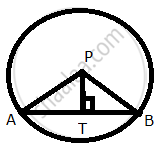Advertisements
Advertisements
Question
ABC is a triangle and G(4, 3) is the centroid of the triangle. If A = (1, 3), B = (4, b) and C = (a, 1), find ‘a’ and ‘b’. Find the length of side BC.
Solution
The coordinates of the vertices of ΔABC are A(1, 3), B(4, b) and C(a, 1).
It is known that A(x1, y1), B(x2, y2) and C(x3, y3) are vertices of a triangle, then
The coordinates of centroid G = `((x_1 + x_2 + x_3)/3, (y_1 + y_2 + y_3)/3)`
Thus, the coordinates of the centroid of ABC are
`((1+4+a).3, (3+b+1)/3) = ((5+a)/3, (4+b)/3)`
It is given that the coordinates of the centroid are G(4, 3).
Therefore, we have
`(5+a)/3 = 4`
`5 + a = 12`
a = 7
`(4+ b)/3 = 3`
4 + b = 9
b = 5
Thus, the coordinates of B and C are (4, 5) and (7, 1) respectively.
Using distance formula, we have
`BC = sqrt((7-4)^2 + (1 - 5)^2)`
`= sqrt(9 + 16)`
`= sqrt25`
= 5 units
APPEARS IN
RELATED QUESTIONS
If A(4, 3), B(-1, y) and C(3, 4) are the vertices of a right triangle ABC, right-angled at A, then find the value of y.
The x-coordinate of a point P is twice its y-coordinate. If P is equidistant from Q(2, –5) and R(–3, 6), find the coordinates of P.
Find the value of y for which the distance between the points A (3, −1) and B (11, y) is 10 units.
Find the distance of a point (7 , 5) from another point on the x - axis whose abscissa is -5.
A line segment of length 10 units has one end at A (-4 , 3). If the ordinate of te othyer end B is 9 , find the abscissa of this end.
Prove that the points (0,3) , (4,3) and `(2, 3+2sqrt 3)` are the vertices of an equilateral triangle.
Show that the points (2, 0), (–2, 0), and (0, 2) are the vertices of a triangle. Also, a state with the reason for the type of triangle.
Prove that the points A (1, -3), B (-3, 0) and C (4, 1) are the vertices of an isosceles right-angled triangle. Find the area of the triangle.
Point P (2, -7) is the centre of a circle with radius 13 unit, PT is perpendicular to chord AB and T = (-2, -4); calculate the length of AB.

Show that points A(–1, –1), B(0, 1), C(1, 3) are collinear.
